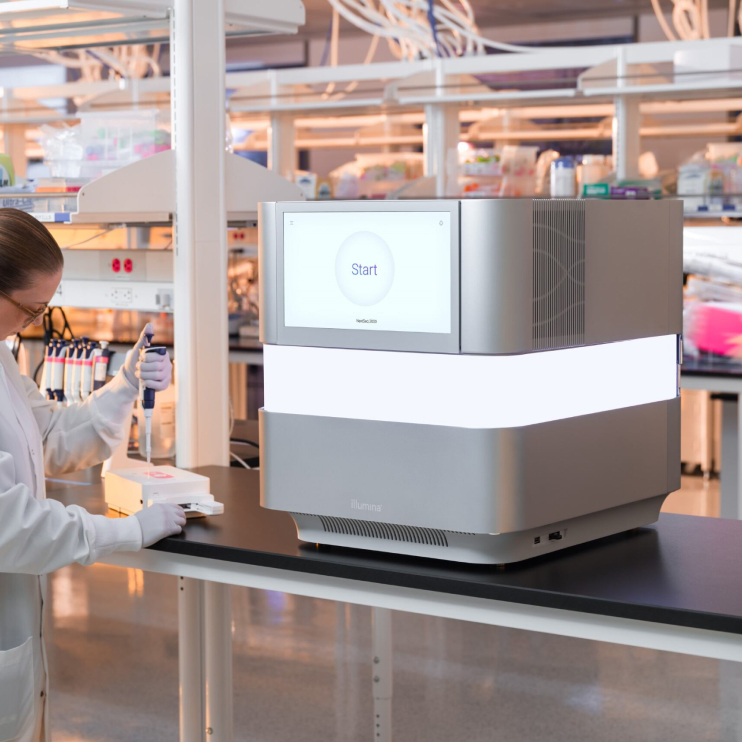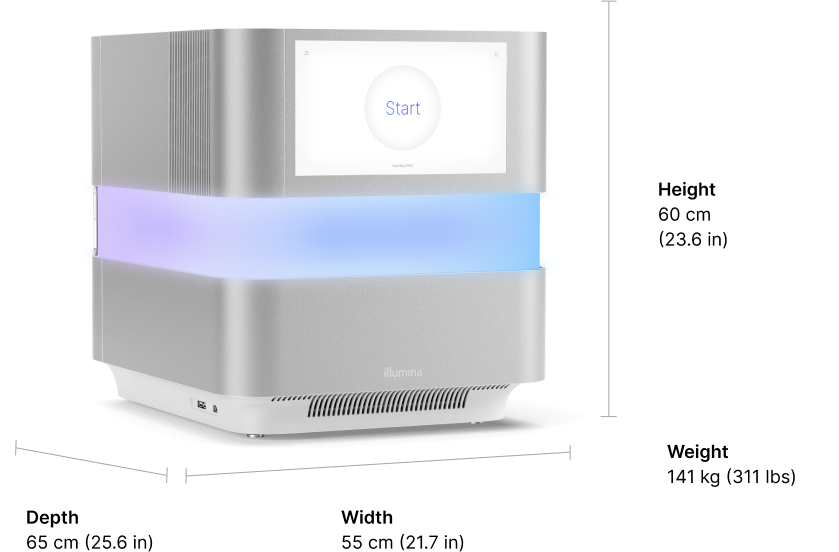| Flow cell type | P1b | P2b | P3b,c | P4c |
|---|---|---|---|---|
| 1 × 50 bp | 90 Gb | |||
| 2 × 50 bp | 10 Gb | 40 Gb | 120 Gb | 180 Gb |
| 2 × 100 bp | 80 Gb | 240 Gb | 360 Gb | |
| 2 × 150 bp | 30 Gb | 120 Gb | 360 Gb | 540 Gb |
| 2 × 300 bp | 60 Gb | 240 Gb |
NextSeq 1000 and NextSeq 2000 Sequencing System specifications
Robust and proven benchtop sequencing
Scalable output, efficient runtimes, and high data quality

Sequencing output per flow cella
NextSeq 1000 and NextSeq 2000 with XLEAP-SBS chemistry
- Output specifications are based on an Illumina PhiX control library at supported cluster densities.
- View standard SBS specifications here.
- P3 and P4 reagents are available for the NextSeq 2000 System only.
Shelf life
NextSeq 1000 and NextSeq 2000 Sequencing Systems
| Item | Storage temperature | P1, P2, P3, P4 Shelf Life |
|---|---|---|
| Cartridge | -25°C to -15°C | 6 months |
| Flow cell | 2°C to 8°C | 6 months |
| RSB with Tween 20a | 2°C to 8°C | 6 months |
- Shipped at room temperature.
Reads passing filter per flow cell
NextSeq 1000 and NextSeq 2000 with XLEAP-SBS chemistry
| Flow cell type | P1a | P2a | P3a,b | P4b |
|---|---|---|---|---|
| Single reads | 100M | 400M | 1.2B | 1.8B |
| Paired-end reads | 200M | 800M | 2.4B | 3.6B |
- View standard SBS specifications here.
- P3 and P4 reagents are available for the NextSeq 2000 System only.
Quality scores and run time
NextSeq 1000 and NextSeq 2000 with XLEAP-SBS chemistry
| Flow cell type | P1 a | P2 a | P3 a,b | P4 b |
|---|---|---|---|---|
| Quality Scoresc | ||||
| 1 × 50 bp | ≥ 90% of bases higher than Q30 | |||
| 2 × 50 bp | ≥ 90% of bases higher than Q30 | |||
| 2 × 100 bp | ≥ 90% of bases higher than Q30 | |||
| 2 × 150 bp | ≥ 90% of bases higher than Q30 | |||
| 2 × 300 bp | ≥ 85% of bases higher than Q30 | |||
| Run Timed | ||||
| 1 × 50 bp | 12 hr | |||
| 2 × 50 bp | 8 hr | 12 hr | 18 hr | 20 hr |
| 2 × 100 bp | 19 hr | 31 hr | 34 hr | |
| 2 × 150 bp | 17 hr | 22 hr | 40 hr | 44 hr |
| 2 × 300 bp | 34 hr | 42 hr | ||
- View standard SBS specifications here.
- P3 and P4 reagents are available for the NextSeq 2000 System only.
- Quality scores are based on an Illumina PhiX control library; performance may vary based on library type and quality, insert size, loading concentration, and other experimental factors.
- Run time includes cluster generation, sequencing, and base calling on a NextSeq 1000 or NextSeq 2000 System.
Estimated sample throughput for key applicationsa
NextSeq 1000 and NextSeq 2000 with XLEAP-SBS chemistry
| Application | P1b | P2b | P3b,c | P4c |
|---|---|---|---|---|
| No. samples | No. samples | No. samples | No. samples | |
Small whole-genome sequencing (300 cycles) 130 Mb genome, 30× coverage |
7 | 30 | 92 | 138 |
Whole-exome sequencing (200 cycles) ~8 Gb per exome, 90× mean coverage |
~2d | 10 | 30 | 45 |
Total RNA-Seq (200 cycles) 50M read pairs per sample |
2d | 8 | 24 | 36 |
mRNA-Seq (200 cycles) 25M read pairs per sample |
4d | 16 | 48 | 72 |
Single-cell RNA-Seq (100 cycles) 5K cells, 20K reads per cell |
1e | 4 | 12 | 18 |
miRNA-Seq or small RNA analysis (50 cycles) 11M reads per sample |
9f | 36f | 108f | 163 |
| 16S RNA sequencing (600 cycles) | 384g | 384g |
- Table values represent estimated number of samples per run. Recommended sequencing depth will largely depend on sample type and experimental objective and will need to be optimized for each study.
- View standard SBS specifications here.
- P3 and P4 reagents are available for the NextSeq 2000 System only.
- Use P1 300-cycle kit.
- P1 reagents are a good option for single-cell quality control experiments.
- Use 100-cycle kits.
- A maximum of 384 unique dual indexes is available from Illumina.
Instrument specifications

-
Instrument configuration
Self-contained, dry instrument with integrated DRAGEN Bio-IT FPGA secondary analysis
-
Laser
Wavelengths449 nm, 523 nm, 820 nm
-
Crated Dimensions
W × D × H92 cm × 120 cm × 118 cm
Weight: 232 kg -
Dimensions
W × D × H55 cm × 65 cm × 60 cm
(21.7 in × 25.6 in × 23.6 in) -
Weight
141 kg (310.9 lb)
-
Crated weight
232 kg (511.5 lb)
Key technologies
Patterned flow cell technology
The NextSeq 1000 and 2000 Systems utilize innovative patterned flow cell technology, which offers an exceptional level of throughput for diverse sequencing applications. Patterned flow cells contain billions of nanowells at fixed locations, a design that provides even spacing of sequencing clusters. This delivers significant increases in sequencing reads and total output.
Lossless genomic data compression technology
Lossless genomic compression is available on-instrument with the NextSeq 1000 and NextSeq 2000 Sequencing Systems. This technology uses an ultra-fast mapping scheme to map reads onto a reference genome, and then store only the data needed to regenerate those reads: a position and a list of differences.
The NextSeq 1000 and NextSeq 2000 Systems are powered by XLEAP-SBS chemistry, a faster, higher quality, and more robust SBS chemistry built on the proven foundation of standard Illumina SBS chemistry. XLEAP-SBS nucleotides use state-of-the-art dyes and novel linkers and blocks that are more resistant to heat, show a 50× reduction in hydrolysis, and 2.5× faster block cleavage to reduce phasing and prephasing. The XLEAP-SBS polymerase is engineered to incorporate nucleotides faster and with higher fidelity than ever before.